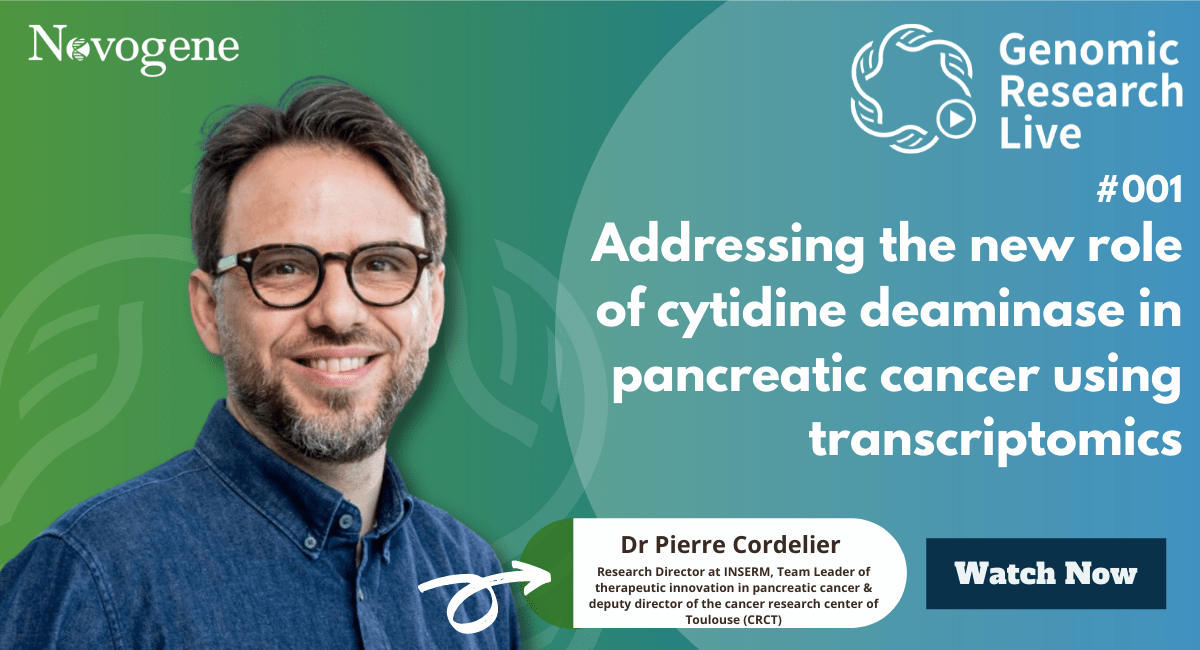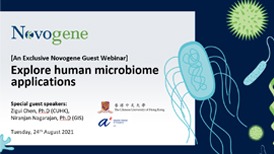

06/11/2025
Decoding Microbial Communities Sequencing Solutions for Microbiome Research at Novogene
Victoria Vidal Tomas Sequencing Specialist Novogene Corporation Inc. Jane Wu Senior Product Manager Novogene Corporation Inc. English, America
05/28/2025
Seeing is Believing: A Beginner's Guide to Spatial Transcriptomics
Zheng Xia Senior Product Manager Novogene Corporation Inc. English, America
04/23/2025
Rutgers Cancer Institute English, America
Transcriptional state dynamics and adaptive tumor evolution in bladder cancer
Dr. Subhajyoti De Associate Professor Department of PathologyRutgers Cancer Institute English, America

04/09/2025
Long-Read Sequencing for Precision Genomics: From De Novo Assembly to Advanced Genomic Analysis
Uma M. Nagarajan Long-read Sequencing Specialist Novogene Corporation Inc. English, America
03/12/2025
From Sample to Sequencing: Optimizing Single-cell Workflows with Novogene and Miltenyi
Carina Emery Product Manager Miltenyi Biotec, Inc. Silu Li Product Specialist Novogene Corporation Inc. English, America
12/11/2024
A Beginner’s Guide to Metabolomics Services at Novogene
Oliver Chang Senior Product Manager Novogene Corporation Inc. English, America
10/30/2024
Novogene’s Introduction to 10x Single Cell RNA Sequencing Services
Ling Qin Product Manager Novogene Corporation Inc. Eric Brenner Technical Support Scientist Novogene Corporation Inc. English, America
10/16/2024
Novogene x PacBio Long-Read Sequencing in Plant and Animal Whole Genome Research
Jacob Brandenburg Segment Marketing Lead Pacific Biosciences Anan Hu Product Manager Novogene Corporation Inc. English, America
09/13/2024
Novogene’s Comprehensive Introduction to Non-coding RNA Sequencing Services and Ultra-low Input RNA Sequencing Pipeline
Xue Zhao Product Manager Novogene Corporation Inc. English, America
07/10/2024
How to identify your microbial sample: Metagenomic Sequencing, Whole genome sequencing or De Novo Sequencing?
Zehua Zhang Product Manager Novogene Corporation Inc. English, America
05/29/2024
Novogene's Comprehensive Methylation Service WGBS, EM-seq, and mRNA-WGBS Analysis
Renee Tamming Technical Support Scientist Novogene Corporation Inc. English, America
04/24/2024
Novogene's Comprehensive Introduction to Human Whole Genome Sequencing Services
Vivian Niewiadonski Technical Support Scientist Novogene Corporation Inc. English, America
03/27/2024
The Application of Multi-omics Data Integration in Brain Atlas Studies
Dr. Yidi Sun Research Group Leader Chinese Academy of Science English, America
02/21/2024
Novogene presents advanced sequencing services featuring NanoString's groundbreaking Digital Spatial Profiling Solutions
Silu Li Product Specialist Novogene Corporation Inc. Sayani Bhattacharjee, PhD Field Application Specialist NanoString Technologies English, America
12/06/2023
A Novogene Guide to Human Genome Sequencing Services
Oliver Chang Senior Product Manager Novogene Corporation Inc. English, America
11/01/2023
Decoding the Cellular Symphony: A Comprehensive Tutorial to Single-Cell RNA-Seq Analysis and Detailed Interpretation of Results
Heming Zhou Product Specialist Novogene Corporation Inc. English, America
09/20/2023
Introduction to Non-coding RNA Sequencing Services—From Sample Submission to Data Analysis
Xue Zhao Product Manager Novogene Corporation Inc. English, America
07/26/2023
Introduction to ChIP-seq and ATAC-seq Services: Unveiling Epigenetic Multi-Omics at Novogene
Heming Zhou Product Specialist Novogene Corporation Inc. English, America
06/28/2023
Beginner's Guide to 16S/18S/ITS Amplicon Metagenomic Sequencing - From Sample Submission to Data Release
Zheng Xia Senior Product Specialist Novogene Corporation Inc. English, America
05/31/2023
Long-reads Sequencing in Human, Plant and Animal Whole Genome Research
Uma Nagarajan, Ph.D. Senior Technical Support Scientist Novogene Corporation Inc. English, America
04/26/2023
Spatial Genomics Workflow: GeoMx DSP Overview and Library Sequencing
Yunmei Karanjawala, PhD Technical Support Supervisor Novogene Corporation Inc. Jay Nakamura Clark Senior Technical Sales Specialist NanoString Technologies English, America
03/29/2023
Kickstart your Whole Exome Sequencing research with IDT and Novogene
Katie Laramore Technical Support Scientist Novogene Corporation Inc. Derek Pappas Field Application Scientist Integrated DNA Technologies (IDT). English, America
02/27/2023
NGS Techniques for Microbial Exploration: An In-depth Workshop
Charles Thompson Senior Product Specialist Novogene Corporation Inc. Kyle Galford Regional Sales Manager Novogene Corporation Inc. English, America
12/12/2022
Third-Generation Sequencing Guide to Whole Genome Re-sequencing
Silu Li Product Specialist Novogene Corporation Inc. English, America
09/30/2022
A Beginner’s Guide to Animal and Plant Whole Genome Sequencing – Re-Sequencing and De novo sequencing with Novogene
Qinyi Gong Product Specialist - Animal and Plant Sequencing Novogene Corporation Inc. English, America
09/05/2022
Eukaryotic mRNA-Seq with Novogene: A Comprehensive Overview
Charles Thompson Eukaryotic mRNA Product Specialist Novogene Corporation Inc. English, America
08/24/2022
Introducción Metagenómica de Amplicones
Esther Campos Fernández Científica de Soporte Técnico Spanish, America
07/27/2022
10x Single Cell RNA Sequencing and Its Application to Liver Disease
Xue (Zoey) Yao Technical Support Scientist II Novogene Corporation Inc. English, America
05/19/2022
ChIP-Seq/RIP-Seq Pipeline – A Beginner’s Guide
Zheng Xia Produt Specialist Novogene Corporation Inc. English, America
06/29/2022
A Beginner’s Guide to Microbial Shotgun Metagenomic Sequencing
Xiaorui Han Principal Product Manager Novogene Corporation Inc. English, America
12/01/2022
Introducing NovoMagic – Novogene’s Online RNA-seq Bioinformatics Analysis Tool
Yue Zhou Product Marketing Manager Novogene Europe English, Europe
10/27/2022
A Beginner’s Guide to DNA Sequencing: Recent Advances
Dr. Raed Hmadi Product Marketing Manager Novogene Europe English, Europe
09/26/2022
Next Generation Sequencing and its Clinical Applications
Larissa Wartha Product Marketing Manager English, Europe
07/21/2022
ncRNA-seq Results Explained: What you can explore with non-coding RNA data
Carolina Jiang Zheng Product Marketing Manager English, Europe
06/16/2022
A Beginner’s Guide to Sequencing Applications and the Microbiome
Dr. Shiqi An Product Marketing Manager English, Europe
06/21/2022
Novogene Agrigenomics Roundtable Discussion
Prof. Robert Park Director of Cereal Rust Research at the School of Life and Environmental Sciences, Faculty of Science, University of Sydney Dr. Jarkko Salojarvi Lead PI/ Assistant Professor Bioinformatics for Molecular Biology and Genomics at the Nanyang Technological University (NTU) Singapore Lu Wang, M.Sc. Senior Product Manager at Novogene AMEA (APAC, Middle-East & Africa) English, Global
05/23/2022
Next Generation Sequencing Solutions for Transcriptomics and Epigenetics Research
Raed Hmadi Product Manager English, Global
04/21/2022
A Beginner's Guide to DNA-seq Bioinformatics Analysis
Yue Zhou Product Marketing Manager Novogene Europe English, Europe
04/21/2022
Fine particulate matter and childhood asthma
Rui Zheng, Ph.D. Lecturer at Nanjing Medical University. English, Global
04/06/2022
mRNA-seq Bioinformatics Analysis
Charles Thompson Senior Technical Support Scientist Novogene Corporation Inc. English, America
03/24/2022
Population genomics of the endangered Chinese crocodile lizard
Hongxin Xie PhD candidate in Prof. Weiguo Du’s lab (Group of Ecological Adaptation and Conservation Biology) at Institute of Zoology, Chinese Academy of Sciences English, Global
03/17/2022
A beginner's guide to DNA sequencing and its applications
Dr. Shiqi An Product Marketing Manager Novogene Europe English, Europe
03/10/2022
The imperative role of Next-Generation sequencing within Aging
Dr. Shelly Patha Technical Support Supervisor Novogene Europe Dr. Payal Ganguly Postdoctoral Research Fellow University of Leeds English, Europe
03/10/2022
The domestication history of lychee and its flowering regulation decoded by full genome sequencing
Dr. Rui Xia Professor at South China Agricultural University English, Global
03/03/2022
Addressing the new role of cytidine deaminase in pancreatic cancer using transcriptomics
Dr Pierre Cordelier Research Director at INSERM, Team Leader of therapeutic innovation in pancreatic cancer & deputy director of the cancer research center of Toulouse (CRCT) English, Global
02/23/2022
Eukaryotic mRNA-seq Pipelines – A Beginner’s Guide
Mario S. IZIDORO Jr., Ph.D. Research Technical Support Scientist Novogene Corporation Inc. English, America
02/17/2022
RNA-seq Results Explained: what you can expect from the analysis
Dr. Shiqi An Product Marketing Manager English, Europe
01/18/2022
Uncover New Discoveries in Plant & Animal Sciences with Highly Accurate Long-Reads
Jake Brandenburg Senior Technical Support Manager PacBio Ira Deveson, Ph.D Head Genomic Technologies Group Kinghorn Centre for Clinical Genomics Garvan Institute of Medical Research Chris Looi, Ph.D Technical Support Manager Novogene English, Asia Pacific, Middle East, Africa

12/08/2021
Novogene End-of-Year Review – Human Whole Genome Sequencing, mRNA Sequencing, 10x Single Cell Sequencing, and non-coding RNA Sequencing
Mario S. IZIDORO Jr., Ph.D. Research Technical Support Scientist Soumi Joseph, Ph.D. Research Technical Support Scientist Uma Nagarajan, Ph.D. Technical Support Scientist English, America
12/02/2021
Sequencing Applications and the Microbiome – A Beginner’s Guide
Dr. Shiqi An Product Marketing Manager Novogene Europe English, Europe
11/18/2021
[Webinar] Improving Human Health through Genomics with Highly Accurate Long Reads
Emily Farrow, Ph.D., CGC Director, Laboratory Operations Genomic Medicine Center Children's Mercy Kansas City Jonas Korlach, Ph.D. Chief Scientific Officer PacBio Tianran Shi, M.Sc. Senior Product Manager Novogene AMEA English, Asia Pacific, Middle East, Africa
11/10/2021
A Beginner’s Guide to Microbial Sequencing - 16S/18S/ITS Amplicon Sequencing vs. Shotgun Metagenomic Sequencing
Xiaorui Han Senior Product Manager Novogene Corporation Inc. English, America
11/11/2021
Guida per principianti all'uso del sequenziamento per facilitare la ricerca microbica
Daniela Scocchia Account Manager for Italy Novogene Europe Italian, Europe
10/20/2021
Eukaryotic mRNA-seq Sample Preparation — Getting Qualified Total RNA Samples
Abhilasha Cheruku Senior Technical Support Scientist @Novogene Corporation Inc. English, America
09/28/2021
Single Cell Sequencing: Sample Preparation
Xiao Hui Man, PhD Scientific Application Manager Novogene AMEA Caroline Chan, PhD Staff Field Applications Scientist 10x Genomics Sen Wong, PhD Product and Technical Application Specialist Miltenyi Biotec Asia Pacific Pte. Ltd English, Asia Pacific, Middle East, Africa
09/15/2021
Premade Library Sequencing – A How-to Guide
Charles Thompson NOVOGENE Technical Support Scientist II English, America
08/19/2021
A beginner's guide to RNA Sequencing
Dr. Li Wei NOVOGENE Senior Product Manager Novogene Europe English, Europe
08/24/2021
Explore Human Microbiome Applications
Tianran Shi Senior Product Manager Novogene AMEA Niranjan Nagarajan, PhD Associate Director and Group Leader Genome Institute of Singapore (GIS) Zigui Chen, PhD Associate Professor The Chinese University of Hong Kong English, Asia Pacific, Middle East, Africa
07/28/2021
10X Single Cell RNA Sequencing (10X scRNA-seq) – From Sample to Data
Yan Liu NOVOGENE Product Specialist English, America
07/09/2021
A Practical Guide to Microbial Solutions
Xinyue Chan, Tianran Shi NOVOGENE Senior Technical Support Manager, Senior Product Manager English, Asia Pacific, Middle East, Africa
06/23/2021
NGS Guide to Non-coding RNAs Sequencing
Leo Li NOVOGENE Product Specialist English, America
06/02/2021
Explore Long Reads Sequencing with Nanopore
Victor A. Albert, Ph.D. University at Buffalo, USA Paola Flórez de Sessions, Ph.D. and Aidil Hamdan Oxford Nanopore Technologies Xiaohui Man, Ph.D. Novogene English, Asia Pacific, Middle East, Africa
06/03/2021
Applying personalized genomics to ash trees
Sophie Xue NOVOGENE Prof. Richard Buggs, Royal Botanical Gardens, Kew English, Europe
05/20/2021
A beginner’s guide to using sequencing to facilitate your microbial research
Li Wei NOVOGENE Senior product manager English, Europe
04/15/2021
Introducing Novogene Europe’s Clinical Sequencing Services
Aina Pi Roig NOVOGENE TS Supervisor of Clinical Services English, Europe
04/21/2021
Introduction to Application of PacBio Sequencing
Emma Zhang NOVOGENE Deputy Product Director English, America
03/18/2021
Understanding RNA-Seq analysis: A beginner’s guide
Li Wei NOVOGENE Product Senior Manager English, Europe RNA-sequencing
03/03/2021
NGS Guide - ChIP-Seq and ATAC-Seq
Harsh Purohit NOVOGENE Technical Support Scientist, Supervisor @Novogene Corporation Inc. English, America Chip-Seq
01/28/2021
Mastermind round table discussion
Yuan yuan Chen, Aina Pi Roig, Rob Ewing, Ricard Argelaguet NOVOGENE English, Europe
02/04/2021
A beginners Guide to RNA-Seq
Joseph Yeoh NOVOGENE Technical Support English, Europe RNA-sequencing
01/27/2021
An Introduction to Plant and Animal Whole Genome Sequencing
Justin Tomblin NOVOGENE Technical Support Scientist English, America PAWGS
01/06/2021
From Single-cell RNA-seq to Spatial Transcriptomics
Watanabe Akira, Ph.D Kyoto University Shyam Prabhakar, Ph.D Genome Institute of Singapore (GIS) Mynn Tan, Ph.D. 10x Genomics English, Asia Pacific, Middle East, Africa
12/03/2020
Novogene End of Year Review
Wei Li NOVOGENE Senior product manager English, Europe Multiple service summary
09/10/2020
Introduction of Novogene transcriptomic and epigenomic solutions
Wei Li NOVOGENE Senior product manager English, Europe RNA-sequencing
07/23/2020
Solutions for microbial genomics
Wei Li NOVOGENE Senior product manager English, Europe Microbial Whole Genome Sequencing
07/09/2020
Introduction to non-coding RNA-seq analysis contents
Wei Li NOVOGENE Senior product manager English, Europe Non-coding RNA Seqeucning
06/25/2020
Microbiome analysis: From sample to data analysis.
Jacob Bak Holm NOVOGENE Director of Scientific Operations English, Europe Shotgun Metagenomic Sequencing
12/09/2020
Comprehensive Data Analysis of Eukaryotic mRNA-Seq
Mario S. Izidoro Jr., Ph.D. NOVOGENE Technical Support Scientist English, America mRNA Seqeucning
11/18/2020
Advantages of Next Generation Sequencing in Epigenetic Studies
Yang Yang NOVOGENE Product Specialist – Epigenetics English, America
10/28/2020
NGS Guide to Human Whole Genome Sequencing
Dafne Alves Winders NOVOGENE Technical Support Scientist English, America hWGS
10/07/2020
Novogene Sample Preparation Best Practices
Amanda Benton NOVOGENE Technical Support Scientist English, America Sample preparation
09/17/2020
Understanding Genetic Variation-An Integrated Personal & Population based Egyptian Genome Reference
Prof.Hauke Busch, Dr.Inken Wohlers - University of LÜBECK UNIVERSITY OF LÜBECK English, Europe
09/16/2020
Elevate and Accelerate Your RNA Sequencing Research – Advancements in Library Prep and Analysis
Dr. Jerell Aguila, Eric Iverson NOVOGENE, SWIFT BIOSCIENCES English, America RNA-sequencing
08/26/2020
Microbial Shotgun Metagenomic Sequencing – From Sample to Data
Harry Han NOVOGENE Product Specialist – Microbial English, America Shotgun Metagenomic Sequencing
08/05/2020
Consistent, Comprehensive, Efficient: An Improved Human Exome Sequencing Solution
Ryan Demeter, Manoj Tripathy IDT, NOVOGENE English, America Human Whole Exome Sequencing
07/28/2020
A Practical Guide to RNA Sequencing for Life Science Research
Xiaohui Man, Ph.D NOVOGENE Bioinformatics Assistant Manager English, Asia Pacific, Middle East, Africa
06/11/2020
Introduction to RNA-seq Analysis Content & Pipeline
Wei Li NOVOGENE Senior Product Manager English, Europe RNA-sequencing
06/10/2020
Uncover the Protein-coding Variants with Cost-effective Human Whole Exome Sequencing
Mary Grantham NOVOGENE Senior Technical Support English, America Human Whole Exome Sequencing
06/03/2020
16S/18S/ITS Amplicon Metagenomic Sequencing – A Beginner’s Guide
Harry Han NOVOGENE Product Specialist English, America 16S/18S/ITS Amplicon Metagenomic Sequencing
05/27/2020
Introducing the service workflow and analysis content of Eukaryotic mRNA Sequencing
Dr. Tovah Salcedo NOVOGENE Deputy Director of Technical Support English, America RNA-sequencing
05/28/2020
Unveiling the Human Genome using cutting-edge Sequencing techniques: WGS & WES
Aina Pi Roig NOVOGENE TS Supervisor of Clinical Service English, Europe Whole Genome Sequencing
05/21/2020
Introducción al análisis de RNA-seq y su pipeline
Marco Dovis NOVOGENE Southern Spain Account Manager Spanish, Europe RNA-sequencing
05/14/2020
Next Generation Sequencing (NGS): A Beginner's Guide
Zimin Zhuang NOVOGENE Product Manager Supervisor English, Europe
05/07/2020
Soluzioni per trascrittomica e studi di espressione genica
Elena Ferrari NOVOGENE Regional Account Manager Italian, Europe
04/30/2020
Introduction to RNA-seq Analysis Contents & Pipelines
Wei Li NOVOGENE Senior Product Manager English, Europe
04/14/2020


